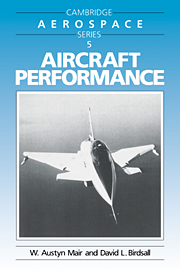Book contents
- Frontmatter
- Contents
- Preface
- Introduction
- 1 Aerodynamic foundations
- 2 Basic flight theory
- 3 Drag equations
- 4 Climbing performance
- 5 Power plants
- 6 Take-off and landing performance
- 7 Fuel consumption, range and endurance
- 8 Turning performance
- 9 Vectored thrust
- 10 Transonic and supersonic flight
- Appendixes
- References
- Index
2 - Basic flight theory
Published online by Cambridge University Press: 02 December 2009
- Frontmatter
- Contents
- Preface
- Introduction
- 1 Aerodynamic foundations
- 2 Basic flight theory
- 3 Drag equations
- 4 Climbing performance
- 5 Power plants
- 6 Take-off and landing performance
- 7 Fuel consumption, range and endurance
- 8 Turning performance
- 9 Vectored thrust
- 10 Transonic and supersonic flight
- Appendixes
- References
- Index
Summary
The first chapter has given an introduction to the characteristics of atmospheric air and has provided a valid basis for the expression of the aerodynamic force developed during flight in that air, but there has not yet been any attempt to consider the balance of forces necessary to satisfy the laws of mechanics. Except for Chapters 6 and 8 and parts of Chapters 4 and 10, this book is directed mainly towards flight with zero or negligible acceleration so that the equations to be developed are those of statics, not dynamics.
Consideration of the effects of varying speed and altitude on the aerodynamic force on an aircraft can be greatly simplified by examining the dependence of the lift and drag coefficients on the Reynolds and Mach numbers. This dependence has already been mentioned briefly and is discussed further in this chapter, where it is shown that for a given aircraft the variations of Reynolds number caused by changing speed and altitude are likely to have only small effects. With increasing Mach number in the high subsonic range there is usually a large increase of drag coefficient and this important effect is introduced briefly, deferring a more detailed account until Chapter 10.
An important measure of the aerodynamic efficiency of an aircraft is the ratio L/D of lift to drag, since there is always a desire to create lift with as little cost in drag as possible. In this chapter the effects of this ratio (or its reciprocal D/L) on some important performance parameters are examined and it is shown that there is a minimum value of D/L which is especially important.
- Type
- Chapter
- Information
- Aircraft Performance , pp. 7 - 29Publisher: Cambridge University PressPrint publication year: 1992



